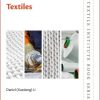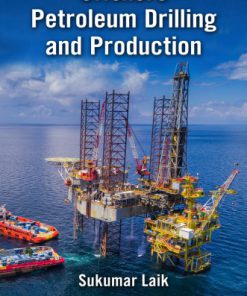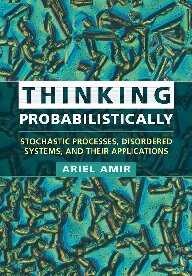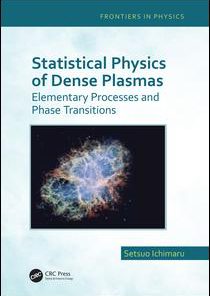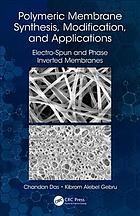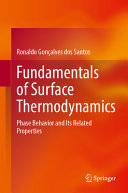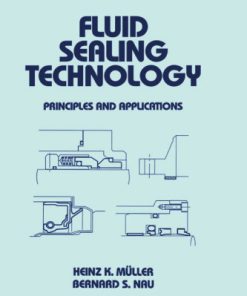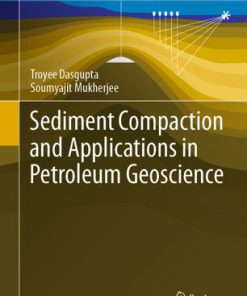Petroleum fluid phase behavior characterization processes and applications 1st Edition by Raj Deo Tewari, Abhijit Dandekar, Jaime Moreno Ortiz 1351857222 9781351857222
$50.00 Original price was: $50.00.$25.00Current price is: $25.00.
Petroleum fluid phase behavior: characterization, processes, and applications 1st Edition by Raj Deo Tewari, Abhijit Y. Dandekar, Jaime Moreno Ortiz – Ebook PDF Instant Download/Delivery: 1351857222, 9781351857222
Full download Petroleum fluid phase behavior: characterization, processes, and applications 1st Edition after payment
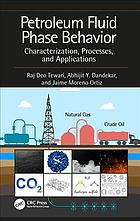
Product details:
ISBN 10: 1351857222
ISBN 13: 9781351857222
Author: Raj Deo Tewari, Abhijit Y. Dandekar, Jaime Moreno Ortiz
This book deals with complex fluid characterization of oil and gas reservoirs, emphasizing the importance of PVT parameters for practical application in reservoir simulation and management. It covers modeling of PVT parameters, QA/QC of PVT data from lab studies, EOS modeling, PVT simulation and compositional grading and variation. It describes generation of data for reservoir engineering calculations in view of limited and unreliable data and techniques like downhole fluid analysis and photophysics of reservoir fluids. It discusses behavior of unconventional reservoirs, particularly for difficult resources like shale gas, shale oil, coalbed methane, reservoirs, heavy and extra heavy oils.
Petroleum fluid phase behavior: characterization, processes, and applications 1st table of contents:
1. Reservoir Fluid Properties
1.1 Introduction
1.2 Gas and Oil
1.2.1 Gas Reservoirs: Hydrocarbon Gases Are Defined Based on Their Occurrences
1.2.1.1 Dry Gas Reservoirs
1.2.1.2 Wet Gas Reservoirs
1.2.1.3 Gas Condensate Reservoirs
1.2.2 Non-hydrocarbon Gases
1.2.2.1 Carbon Dioxide (CO2)
1.2.2.2 Hydrogen Sulfide (H2S) Gas
1.2.2.3 Mercury (Hg)
1.2.2.4 Coalbed Methane Gas
1.2.2.5 Shale Gas
1.2.2.6 Gas Hydrates
1.2.3 Physical Properties of Gas
1.2.3.1 Gas Density ρg
1.2.3.2 Gas Gravity, γg
1.2.3.3 Gas Viscosity, µg
1.2.3.4 Gas Deviation Factor Z
1.2.3.5 Gas Formation Volume Factor, Bg
1.2.4 Oil Reservoir Types
1.2.4.1 Black Oil Reservoirs
1.2.4.2 Volatile Oil Reservoirs
1.2.4.3 Heavy and Extra-Heavy Oil
1.2.5 Physical Properties of Crude Oil
1.2.5.1 Bubble-Point Pressure, Pb
1.2.5.2 Oil Formation Factor, Bo
1.2.5.3 Gas Formation Volume Factor, Bg
1.2.5.4 Solution Gas–Oil Ratio, Rs
1.2.5.5 Oil Viscosity, µo
1.2.5.6 Oil Density, ρo
1.2.5.7 Oil Compressibility, co
1.2.6 Chemical Properties
1.2.6.1 Paraffins
1.2.6.2 Naphthenes
1.2.6.3 Aromatics
1.2.6.4 Resins and Asphaltenes
1.3 Non-hydrocarbon Crude Components
1.4 Ternary Presentations of Crude Oil Classifications
1.4.1 Water Properties
1.4.1.1 Composition and Salinity
1.4.1.2 Formation Volume Factor
1.4.1.3 Density
1.4.1.4 Compressibility
1.4.2 Water Solubility in Hydrocarbon System
1.4.3 Phase Behavior
1.4.3.1 Gibb’s Law
1.4.4 Pure-Component Systems
1.5 PV Diagram for Pure Systems
1.6 Binary Systems
1.7 Effect of Composition on Phase Behavior
1.8 P–x and T–x Diagrams
1.9 Retrograde Condensation
1.10 Multicomponent Phase Behavior of Hydrocarbon
1.10.1 Phase Behavior of Oil
1.10.1.1 Undersaturated Oil
1.10.1.2 Saturated Oil
1.10.1.3 Volatile Oil
1.10.2 Phase Behavior of Gas
1.10.2.1 Dry Gas
1.10.2.2 Wet Gas
1.10.2.3 Gas Condensate
1.10.3 Comparison of Phase Diagram of Hydrocarbon Fluids
1.10.4 Phase Diagram of Reservoirs with Gas Cap
1.11 Ternary Diagram
1.11.1 Ternary Diagrams as a Function of Pressure
1.11.2 Equation of States
1.11.2.1 Period 1
1.11.2.2 Period 2
1.11.2.3 Period 3
1.11.3 van der Waals Equation
1.11.4 Redlich–Kwong Equation
1.11.5 Soave–Redlich–Kwong Equation
1.11.6 Peng–Robinson Equation
1.11.7 Benedict–Webb–Rubin Equation
1.12 Comparative Assessment of RK, SRK, and PR EOS
1.12.1 Redlich–Kwong EOS
1.12.2 Soave–Redlich–Kwong and Peng–Robinson EOS
1.12.3 Zc as a Measure of Goodness of an EOS
1.12.4 “Universal” Zc Predicted by Different EOS
1.12.5 Vapor–Liquid Equilibrium
1.12.6 Pressure and Temperature
1.12.7 Fluid Contacts
1.12.8 Reservoir Temperature
1.12.8.1 Impact of Temperature on Subsurface Parameters
1.12.8.2 Subsurface Gas Density
1.12.8.3 Subsurface Fluid Viscosity
1.12.8.4 Geothermal Gradient
1.12.8.5 Sources of Temperature Measurement
1.12.9 Reservoir Fluid Analysis
1.12.9.1 Compositional Variations
1.12.10 Non-equilibrium Distribution of Hydrocarbons
References
2. Fluid Characterization and Recovery Mechanism
2.1 Introduction
2.2 Reservoir Recovery Processes
2.2.1 Rock-Fluid Expansion
2.2.2 Depletion or Solution Gas Drive Reservoirs
2.2.3 Gas-Cap Drive
2.2.4 Water-Drive Reservoirs
2.2.5 Combination Drive
2.2.6 Segregation Drive
2.2.6.1 General Material Balance Equation
2.3 Gas Reservoirs
2.3.1 Volumetric Gas Reservoirs
2.3.2 Water-Drive Gas Reservoir
2.3.3 Gas Condensate Reservoirs Production
2.3.4 Fluid Characterization for Reservoir Simulations
2.4 Secondary Recovery
2.4.1 Water Injection
2.4.2 Gas Injection
2.4.2.1 Flue Gas Injection
2.4.2.2 Nitrogen Injection
2.4.2.3 Carbon Dioxide Injection
2.4.3 Gas Cycling
2.4.4 CO2 Sequestration
2.5 Tertiary Recovery
2.5.1 Chemical EOR
2.5.1.1 Polysaccharides Biopolymer
2.5.1.2 Synthetic Polymer
2.5.2 Effect of Concentration and Shear Rate on Viscosity
2.5.3 Rheology of Polymer and Shear Impact
2.5.4 Salinity Impact
2.5.5 Adsorption
2.5.6 Surfactant Flooding
2.5.6.1 Fluid–Fluid Interactions
2.5.6.2 Phase Behavior
2.6 Gas-Based EOR
2.6.1 Immiscible and Miscible Water-Alternating Gas (IWAG) Injection
2.6.2 Miscible Flooding
2.6.2.1 Multi-Contact Miscibility
2.6.2.2 Vaporizing Gas Drive
2.6.2.3 Condensing Gas Drive
2.6.2.4 Condensing and Vaporizing Drive
2.6.3 CO2 Sequestration
2.6.3.1 Trapping Mechanisms and Long-Term Fate of CO2
2.7 Thermal EOR
2.7.1 Cyclic Steam Stimulation
2.7.2 Steam Flooding
2.7.3 Steam Assisted Gravity Drainage (SAGD)
2.7.4 In Situ Combustion
2.8 PVT Data for Thermal EOR Processes
References
3. Advanced Fluid Sampling and Characterization of Complex Hydrocarbon Systems
3.1 Introduction
3.2 Hydrocarbon Sampling
3.2.1 Sampling Location Considerations
3.2.1.1 Pressure Data
3.2.1.2 Compositional Gradients and API
3.2.2 Sampling Challenges
3.2.2.1 Downhole Sampling
3.2.2.2 Surface Sampling
3.3 Field Sampling
References
4. Planning of Laboratory Studies
4.1 Introduction
4.2 Conventional Oil and Gas Experiments
4.3 Special Laboratory Experiments
4.3.1 Swelling Test
4.3.2 Minimum Miscibility Pressure
4.3.3 Multiple Contact Miscibility
4.3.3.1 Vaporizing Gas Drive
4.3.3.2 Condensing Gas Drive
4.3.4 Fluid Compatibility Studies
4.3.5 Asphaltene Precipitation Envelope
References
5. Phase Behavior of Petroleum Reservoir Fluids in the Dense Phase or Supercritical Region
5.1 Definition of Dense or Supercritical Phase
5.2 Variation of Dense Phase Fluid Properties with Temperature and Pressure
5.3 High Temperature High Pressure (HTHP) and/or Hyperbaric Reservoir Fluids
5.4 Measurement and Modeling of Dense Phase Fluid Properties
5.5 Practical Significance of Dense Fluid Phase in Transportation and EOR
5.6 Successful Applications—Case Studies
5.6.1 Dense Phase CO2
5.6.2 Dense Phase or Supercritical Water (SCW)
5.6.3 The General Prominence of Supercritical Fluids
References
6. Special Characterization for EOR Processes
6.1 Introduction
6.2 EOS Recap
6.3 EOS Role on Numerical Simulation
6.4 EOS Calibration
6.4.1 Slimtube Calibration
6.5 EOS Grouping
6.5.1 Asphaltenes
6.6 EOS Dynamic Testing
6.6.1 Finite-Difference Considerations
References
7. Compositional, Fluid Property, and Phase Behavior Characteristics of Unconventional Reservoir Fluids
7.1 Significance of Unconventional Reservoir Fluids
7.2 Reservoir Fluids Containing Unusually Large Fractions of Non-hydrocarbon Components
7.2.1 Gaseous Non-hydrocarbons
7.2.2 Mercury
7.2.2.1 Impact of Association of Hg with Petroleum Reservoir Fluids
7.3 Formation of Solid CO2 and Effect of CO2 on Paraffin Wax
7.4 Compositional Characteristics of Shale Gas and Shale Oil vs. Conventional Reservoir Fluids
7.5 Fluid Property and PVT Characteristics of Fluids Containing Large Proportions of Non-hydrocarbons and Shale-Based Fluids vs. Conventional Fluids
7.5.1 Fluid Phase Behavior of Acid Gases and Their Mixtures with Hydrocarbons
7.5.2 Fluid Phase Behavior and Properties of Shale Reservoirs
7.6 Measurement and EOS Modeling of Unconventional Reservoir Fluids—State of the Art
References
8. Porous Media Effects on Phase Behavior of (Unconventional) Petroleum Reservoir Fluids
8.1 Practical Significance and Implications of Porous Media Effects on Phase Behavior
8.2 Capillary Pressure
8.2.1 Gas–Oil IFT
8.2.2 Pore Size and Pore Size Distribution
8.3 Inclusion of Confinement in Phase Behavior
8.3.1 Capillary Pressure in Flash or Vapor–Liquid Equilibria (VLE) Calculations
8.3.2 Flash or Vapor–Liquid Equilibria (VLE) Calculations using Modified Critical Temperature and Pressure
8.3.3 Bubble-Point Calculations for the Methane–n-Butane Binary System Including Capillary Pressure
8.3.4 Correcting Bulk PVT Data for Confinement
8.4 Handling of Porous Media Effects on Phase Behavior in a Compositional Reservoir Simulator
References
9. Compositional and Phase Behavior Effects in Conventional and Exotic Heavy Oil EOR Processes
9.1 CO2 Induced Hydrocarbon Liquid–Liquid Phase Split and Phase Behavior Type
9.2 Experimental Observations and EOS Modeling of Hydrocarbon Vapor–Liquid–Liquid or Liquid–Liquid Phase Split
9.2.1 Experimental Observations
9.2.2 Stability Analysis and EOS Modeling
9.2.3 Handling of Multiple Phases in a Compositional Reservoir Simulator
9.3 Practical Significance of CO2 Induced Heavy Oil Phase Behavior
9.4 Compositional Changes in a Heavy Oil in Exotic EOR Processes—Microbial and In Situ Combustion
9.4.1 Microbial Enhanced Oil Recovery (MEOR)
9.4.2 In Situ Combustion (ISC)
9.5 Case Studies and Recent Advances
References
10. Flow Assurance in EOR Design and Operation
10.1 Flow Assurance
10.2 Wax
10.2.1 Chemistry
10.2.2 Phase and Physical Properties
10.2.3 Laboratory Testing and Modeling
10.2.3.1 Deposition Modeling—Wax Composition
10.2.3.2 Deposition Modeling—WAT
10.2.3.3 Deposition—Wax Disappearance Temperature
10.2.3.4 Pour Point Temperature
10.2.3.5 Rheology—Gelation Temperature
10.2.3.6 Rheology—Viscosity
10.2.3.7 Wax Deposition
10.2.3.8 Rheology—Yield Stress
10.2.4 Prevention and Mitigation
10.2.4.1 Gelling/Pour Point Management
10.3 Asphaltene
10.3.1 Chemistry
10.3.2 Phase and Physical Properties
10.3.3 Laboratory Testing and Modeling
10.3.4 Prevention and Mitigation
10.4 Hydrate
10.4.1 Phase and Physical Properties
10.4.2 Laboratory Testing and Modeling
10.4.2.1 Hydrate Formation Correlations
10.4.2.2 Makogan
10.4.2.3 Kobayashi et al.
10.4.2.4 Berge Correlation
10.4.3 Prevention and Mitigation
10.5 Emulsion
10.5.1 Formation of Emulsion
10.5.2 Emulsion Stability
10.5.3 Laboratory Studies
10.5.4 Demulsification
10.5.4.1 Reservoir Souring, Corrosion, and Aquathermolysis
References
11.EOS and PVT Simulations
11.1 Introduction
11.2 Black Oil and Compositional Models
11.3 PVT Model Validation
11.3.1 Sample Contamination Validation
11.3.2 EOR Injection Considerations
11.4 PVT Correlations
11.5 Impact of PVT Uncertainty on Volume and Recovery Estimations
References
12.Empirical Relations for Estimating Fluid Properties
12.1 Bubble-Point Pressure Correlations
12.1.1 MB Standing Correlation
12.1.2 Glaso
12.1.3 Vasquez and Beggs
12.1.4 Al-Marhoun
12.1.5 De Ghetto et al. for Heavy Oil and Extra-Heavy Oil
12.1.6 Hanafi et al.
12.1.7 Petrosky and Farshad
12.1.8 Velarde et al.
12.1.9 Omar and Todd
12.1.10 Lasater Bubble-Point Pressure
12.1.11 Dew-Point Correlations
12.2 Solution Gas Oil Ratio Correlations
12.2.1 Standing
12.2.2 Glaso
12.2.3 Vasquez and Beggs
12.2.4 Al-Marhoun
12.2.5 De Ghetto et al.
12.2.6 Hanafi et al.
12.2.7 Petrosky and Farshad
12.2.8 Velarde et al.
12.3 Formation Volume Factor
12.3.1 Arp’s Correlation
12.3.2 Standing Correlation
12.3.3 Glaso
12.3.4 Vasquez and Beggs
12.3.5 Al-Marhoun
12.3.6 Petrosky–Farshad Correlation
12.3.7 Omar and Todd’s Correlation for Malaysian Crudes
12.3.8 Hanafi et al.
12.3.9 De Ghetto et al.—Heavy Oil and Extra-Heavy Oil
12.3.10 Petrosky and Farshad
12.4 Oil Compressibility Correlations
12.4.1 Vasquez and Beggs
12.4.2 Hanafi et al.
12.4.3 De Ghetto et al.
12.4.4 Petrosky and Farshad
12.5 Viscosity Correlations
12.5.1 Beggs and Robinson
12.5.2 De Ghetto et al.
12.5.3 Hanafi et al.
12.5.4 Khan et al. (Saudi Arabian Oil)
12.5.5 Ng and Egbogah
12.5.6 Vasquez–Beggs correlation
12.5.7 Gas Viscosity, µg
12.5.7.1 Lee–Gonzalez–Eakin
12.5.8 Water Viscosity by Meehan
12.5.9 Beal
12.6 Density and Gravity
12.6.1 Hanafi et al.
12.7 Minimum Miscibility Pressure
12.8 Uncertainty in PVT Data
People also search for Petroleum fluid phase behavior: characterization, processes, and applications 1st:
phase behavior of petroleum reservoir fluids
petroleum based fluids
fluid phase behavior
petroleum fluid
a viscous liquid derived from petroleum used for energy
Tags: Petroleum, behavior, characterization, processes, applications, Raj Deo Tewari, Abhijit Dandekar, Jaime Moreno Ortiz
You may also like…
Mathematics - Probability
Physics - Theoretical Physics
Cookbooks


